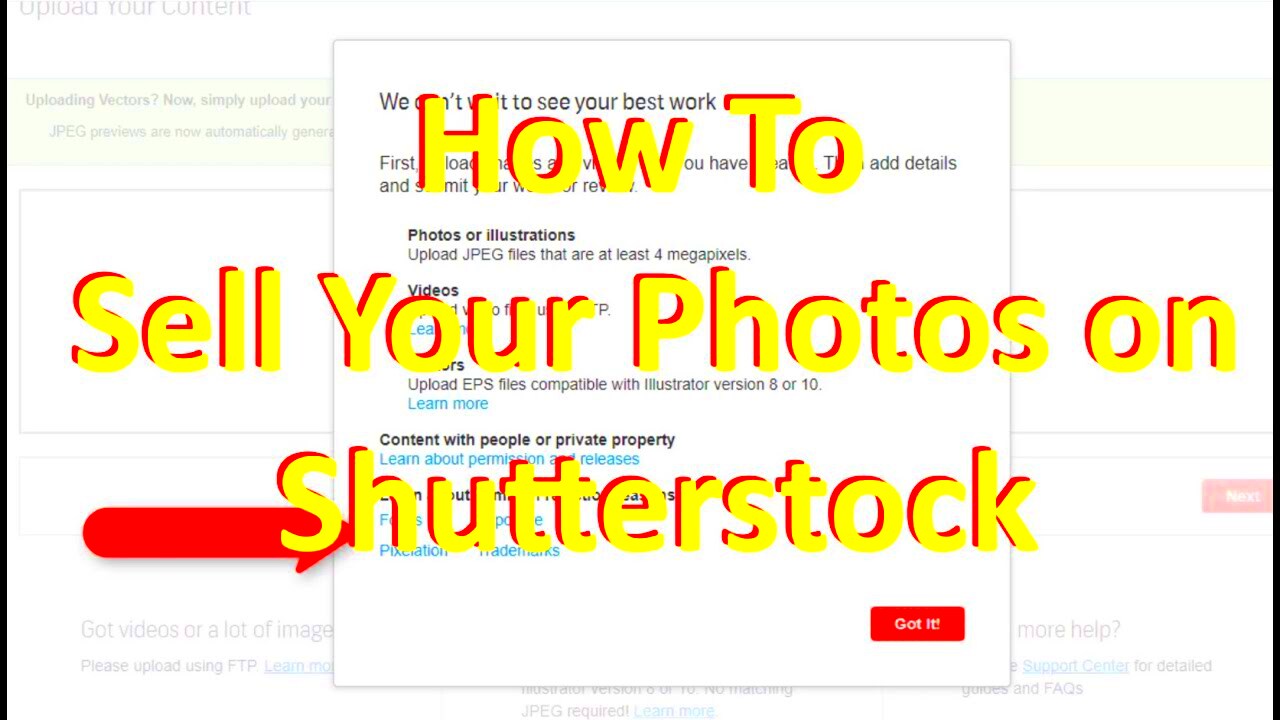Have you ever considered transforming your love for photography into a reliable source of income? Selling your pictures on
Shutterstock could be a thrilling and profitable venture. If you're anything like me, you've snapped countless shots capturing everything, from moments to breathtaking sceneries.
Shutterstock provides a space for these photos to reach a worldwide audience.It's not solely about sharing your creations; it's about showcasing your viewpoint to the world and being compensated for it. Let's explore how you can embark on this path.
Understanding Shutterstock’s Platform
 Shutterstock
Shutterstock stands out as a major player in the realm of stock photography. It serves as a bridge between photographers and customers seeking top notch visuals for a range of purposes spanning marketing to publishing. Lets take a look at the process behind it all.
- Marketplace: Shutterstock’s marketplace hosts millions of images. Buyers search for images by keywords, and your images can appear in their search results if they match their needs.
- Submission Process: Contributors upload their images, which are reviewed by Shutterstock’s team. Approved images become part of the Shutterstock library and are available for purchase.
- Royalty System: When someone buys a license to use your image, you earn a royalty. The more your images are downloaded, the more you can potentially earn.
As a contributor you’re not merely a photographer; you’re part of an extensive community of artists. I recall the mix of excitement and nerves I felt when I initially joined
Shutterstock. It was exhilarating yet somewhat daunting to see my creations showcased alongside established professionals in the field. Nevertheless as time went on I discovered how to maneuver through the platform efficiently and utilize its features to present my work.
Steps to Get Started with Shutterstock

Starting out on
Shutterstock is pretty simple, but it does need a bit of groundwork. Here’s a guide to walk you through the process.
- Sign Up: Create an account on Shutterstock. You'll need to provide basic information and agree to their terms and conditions.
- Submit Your Portfolio: Before you can upload your images, you need to submit a portfolio for review. This helps Shutterstock understand the quality and style of your work.
- Upload Images: Once approved, you can start uploading images. Make sure to include relevant keywords and descriptions to help buyers find your work.
- Set Up Your Account: Fill out your payment information and set your preferences. This will ensure you get paid when your images are purchased.
- Review and Manage: Regularly check your Shutterstock account to monitor your sales and manage your portfolio. Keep an eye on trends and feedback to improve your submissions.
At the beginning I concentrated on sharing a variety of pictures to find out what resonated most with the audience. As time went on I fine tuned my approach according to the preferences of buyers and the input I received. Its an ongoing journey but every move you make brings you nearer to reaching your goals, on
Shutterstock.
Preparing Your Images for Submission

Preparing your images for Shutterstock goes beyond handling the details—it's about showcasing your artistry in the way. Having gone through this process myself I can assure you that careful preparation is crucial for leaving a lasting impact. Here are some tips to help you align your images with Shutterstock's requirements:
- Image Quality: Shutterstock looks for high-resolution images with sharp details. Avoid images with noise or blurriness. Remember, buyers want clear and crisp visuals.
- File Format: Submit your images in JPEG format. Make sure they’re saved at the highest quality setting to preserve details and avoid compression artifacts.
- Keywords and Descriptions: Adding relevant keywords and descriptions is crucial. Think about what terms buyers might use to find your images. For example, if you’ve captured a bustling market scene, use keywords like “market,” “busy,” and “USA” to help your image appear in searches.
- Model Releases: If your images include recognizable people, ensure you have model releases. This legal document gives Shutterstock permission to use the images commercially.
- Property Releases: For images of private properties or branded products, a property release is necessary to avoid legal issues.
I recall that my initial submissions faced rejections due to issues such as file formats or insufficient descriptions. It was a process, but once I grasped the requirements I began to notice improvements in my outcomes. Being meticulous about details really has an impact.
Pricing and Earnings on Shutterstock

Grasping how you generate income on Shutterstock can assist you in maximizing your endeavors. While the pricing and revenue structure may appear somewhat intricate at first glance it becomes quite simple once you familiarize yourself with it. Allow me to provide you with an overview,
- Royalty Rates: Shutterstock pays royalties based on the licensing type and your contributor level. Typically, you earn between 15% and 40% of the sale price of each image download.
- Licensing Types: Shutterstock offers various licenses, including standard and enhanced. Standard licenses are more common and offer lower royalties, while enhanced licenses cost more and provide higher earnings.
- Contributor Levels: As you upload more images and make more sales, you can reach higher contributor levels. Higher levels mean better royalty rates. It’s like climbing a ladder—each step up improves your earnings.
- Sales Performance: Your earnings also depend on how well your images perform. Images that align with current trends or fulfill niche needs often see more downloads.
In the beginning my income was quite low. It took me a while to establish a collection of work and grasp the kinds of images that people wanted. However through determination and an emphasis on producing content my earnings steadily increased. Being patient and staying consistent are crucial factors.
Tips for Success as a Shutterstock Contributor
Achieving success as a contributor on Shutterstock goes beyond simply sharing pictures. It requires careful planning and a commitment to refining your methods. Here are a few suggestions that have proven beneficial for me throughout my journey.
- Focus on Quality: Always prioritize quality over quantity. High-quality images that stand out are more likely to be downloaded.
- Stay Updated: Trends in stock photography change frequently. Keep an eye on what’s popular and adapt your portfolio accordingly. For instance, during the pandemic, there was a surge in demand for images related to remote work and health.
- Engage with the Community: Join forums or groups of other Shutterstock contributors. Sharing experiences and tips can provide valuable insights and motivation.
- Regular Uploads: Consistency is important. Regularly upload new images to keep your portfolio fresh and relevant.
- Analyze Performance: Use Shutterstock’s analytics tools to understand which images are performing well and why. Adjust your strategy based on these insights.
Throughout my path these insights have been incredibly valuable. They have aided me in honing my abilities grasping market needs and creating a thriving portfolio. Its an ongoing journey of growth but each advancement comes with its own set of rewards.
Common Challenges and How to Overcome Them
Getting started on Shutterstock can be an adventure but it does come with its challenges. I’ve encountered my share of obstacles along the way and figuring out how to deal with them has been part of my personal growth journey. Here are some problems you may run into and some suggestions on how to handle them:
- Rejection of Submissions: One of the most frustrating challenges is having your images rejected. This often happens due to issues with image quality, file format, or inadequate metadata. To overcome this, ensure your images are high-resolution, follow Shutterstock’s submission guidelines closely, and provide detailed keywords and descriptions. Sometimes, it’s just a matter of revising and resubmitting.
- Finding the Right Niche: It can be tough to determine what images will be in demand. Research current trends and review popular images on Shutterstock to understand what buyers are looking for. Don’t hesitate to experiment with different styles and subjects until you find your niche.
- Standing Out in a Crowded Market: With millions of images available, getting yours noticed can be challenging. Focus on unique angles and perspectives, and pay attention to composition and lighting. Consistently uploading high-quality images can also help build your presence.
- Dealing with Low Earnings: If your earnings aren’t as high as you hoped, consider expanding your portfolio with a diverse range of images. Evaluate which of your images perform well and create more content in those categories.
In my view sticking with it is key. Each obstacle you encounter presents a chance to grow and develop. Rather than feeling disheartened by challenges use them as building blocks to fine tune your strategy and strengthen your skill set.
Frequently Asked Questions
Here are a few frequently asked questions about selling photos on Shutterstock along with some answers that could help clear up any confusion.
How long does it take to get approved as a contributor?
- Approval can take a few days to a week. Shutterstock reviews your portfolio to ensure it meets their quality standards. In my case, it took about five days, but it’s worth the wait.
Can I sell the same images on other platforms?
- Yes, you can. Shutterstock allows you to sell your images on other stock photography websites, but make sure you’re not exclusive to any one platform unless specified.
What types of images sell best?
- High-quality, clear images with popular themes such as business, lifestyle, and nature tend to perform well. However, niche topics can also attract buyers looking for specific content.
How often should I upload new images?
- Regular uploads are beneficial. Aim to add new images consistently—whether that’s weekly or monthly—to keep your portfolio fresh and engaging.
What should I do if my images are rejected?
- Review the feedback provided, if any, and make necessary adjustments. Recheck your image quality and metadata, and don’t hesitate to seek advice from other contributors or forums.
These commonly asked questions frequently arise in conversations with other contributors. They serve as a helpful resource for exploring the realm of stock photography and can assist in alleviating any initial doubts you may have.
Conclusion: Is Selling Images on Shutterstock Worth It?
Is it really worth putting in the effort to sell pictures on Shutterstock? From what I’ve seen, I would say it is, but there are a few things to consider. Shutterstock provides an opportunity for photographers to showcase their talent to people worldwide and make money. It’s a great way to turn your love for photography into a source of income and witness the impact of your images.Achieving success is not an instant process. It demands hard work, a sharp awareness of market shifts and a dedication to creating top notch content. The early stages may pose difficulties but through perseverance you can transform this into a fulfilling pursuit. It's an adventure rich in lessons, personal development and above all the pleasure of showcasing your distinct perspective to the world.Seeing my photos being utilized in different projects brings me immense joy and the consistent income flow makes it all worth it. If you love photography and are willing to work hard Shutterstock is definitely worth considering.
 Shutterstock stands out as a major player in the realm of stock photography. It serves as a bridge between photographers and customers seeking top notch visuals for a range of purposes spanning marketing to publishing. Lets take a look at the process behind it all.
Shutterstock stands out as a major player in the realm of stock photography. It serves as a bridge between photographers and customers seeking top notch visuals for a range of purposes spanning marketing to publishing. Lets take a look at the process behind it all. Starting out on Shutterstock is pretty simple, but it does need a bit of groundwork. Here’s a guide to walk you through the process.
Starting out on Shutterstock is pretty simple, but it does need a bit of groundwork. Here’s a guide to walk you through the process. Preparing your images for Shutterstock goes beyond handling the details—it's about showcasing your artistry in the way. Having gone through this process myself I can assure you that careful preparation is crucial for leaving a lasting impact. Here are some tips to help you align your images with Shutterstock's requirements:
Preparing your images for Shutterstock goes beyond handling the details—it's about showcasing your artistry in the way. Having gone through this process myself I can assure you that careful preparation is crucial for leaving a lasting impact. Here are some tips to help you align your images with Shutterstock's requirements: Grasping how you generate income on Shutterstock can assist you in maximizing your endeavors. While the pricing and revenue structure may appear somewhat intricate at first glance it becomes quite simple once you familiarize yourself with it. Allow me to provide you with an overview,
Grasping how you generate income on Shutterstock can assist you in maximizing your endeavors. While the pricing and revenue structure may appear somewhat intricate at first glance it becomes quite simple once you familiarize yourself with it. Allow me to provide you with an overview,
 admin
admin








